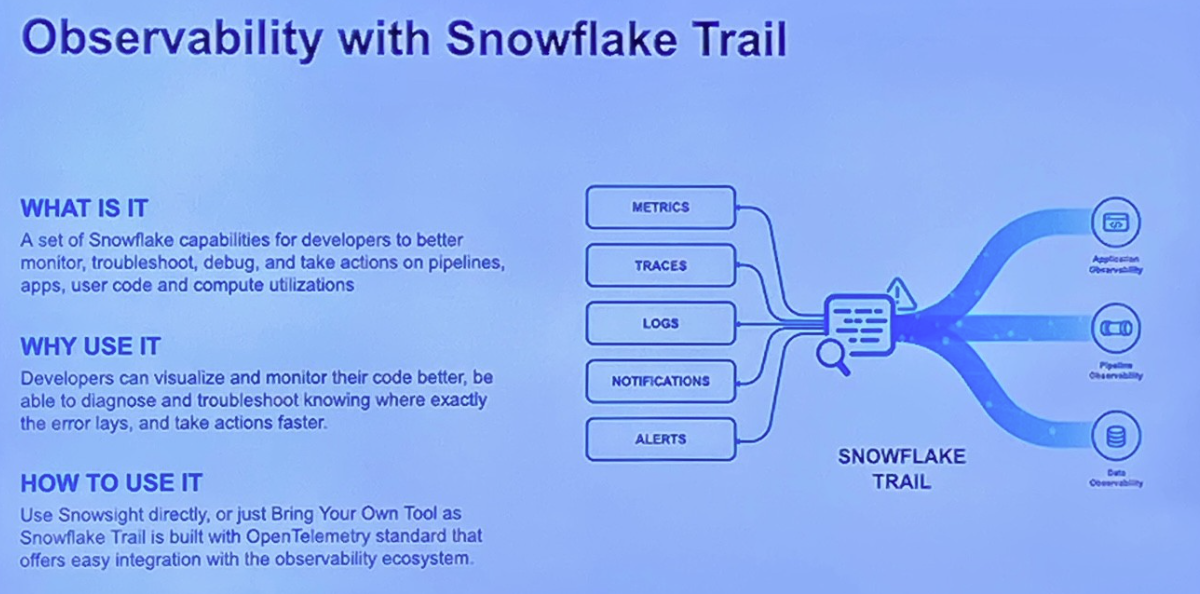Snowflake fleshed out more of its artificial intelligence strategy and announced a bevy of data management tools designed to advance enterprise AI while keeping its data analytics base in the fold. A push into native applications on the Snowflake platform highlighted how building and managing data apps will work for partners and customers.
The announcements, made at Snowflake Summit, come at a big moment for the company. Snowflake has a new CEO in Sridhar Ramaswamy, mixed financial results and is sparring with journalists and analysts over a Ticketmaster data breach.
Snowflake is also making a larger bet on open source with its Arctic large language model as well as open sourcing the Polaris Catalog to help with data interoperability. In addition, the Snowflakes extend the duel with Databricks as well as MongoDB in some areas. Broadly speaking, here are the three themes Snowflake emphasized.

Speaking during a keynote, Ramaswamy said: "Every announcement you will hear today you're gonna get simplicity by leveraging AI or ML apps or notebooks. You know that every one of our innovations is deeply integrated with ease of use, and governments built him and this is why you can count on us as a partner."
Constellation Research analyst Doug Henschen said:
"Here at Summit, Snowflake execs talked to analysts about sources of growth starting with the core, meaning continued migration of customers to the Snowflake Data Cloud, with resulting increases in analytics, data engineering and data marketplace workloads. Beyond the core, they see huge opportunities around Snowflake-Native Applications built using Snowpark Container Services and Streamlit, as well as around increasing AI, GenAI and ML workloads using Snowflake Cortex AI and Snowflake ML.
Snowflake’s push to improve data engineering capabilities and developer productivity is at least as important as it’s move to extend its support for AI, GenAI and ML workloads. Announcements on this front included Native App Framework integration with Snowpark Container Services, DevOps improvements, and Snowflake Trail, a set of capabilities to better monitor, troubleshoot, debug and take actions on pipelines, apps, code, and compute utilization. Data engineering workloads drive revenue, so improving productivity with Snowflake Trail for better observability, new automated and declarative CI/CD capabilities, Git integration, and tools such as a new command line interface and new REST APIs are all aimed at ramping up developer productivity to increase the value of the platform."
Here's a look at what Snowflake announced at Snowflake Summit.
Cortex AI, machine learning, Snowflake AI and ML Studio
Cortex Analyst and Cortex Search. Cortex, Snowflake's flagship data platform, will get Cortex Analyst, which enables enterprises to build applications on top of their data in Snowflake. The move recognizes that enterprise developers will increasingly use data platforms to build and extend applications.
Cortex Search uses the retrieval and ranking technology from Neeva, which was acquired by Snowflake a year ago, and pairs it with Snowflake Arctic embed. Users can build applications based on documents and text-based data sets.
Snowflake AI and ML Studio. Snowflake launched Snowflake AI and ML Studio in private preview to run along with Cortex AI, which provides multiple foundational models to users. With a no-code and low-code interface, Snowflake is betting its AI and ML studio can enable customers to test, evaluate and deploy models to fit use cases.
Snowflake Cortex Fine-Tuning. The company said Cortex Fine-Tuning is in public preview via AI and ML Studio or as a SQL function.
Snowflake ML enhancements. Snowflake announced the public previews of Snowpark Pandas AIP, Snowflake Notebooks and Snowflake Feature Store. The Snowflake Model Registry is generally available.
Snowflake also said it has adopted Nvidia AI Enterprise to integrate NeMo Retriever microservices into Snowflake Cortex AI. Snowflake Arctic is also supported by Nvidia TensorRT-LLM software.
Snowflake Trail, optimizations, Snowflake Horizon
Snowflake also launched an effort to improve observability for developers with the launch of Snowflake Trail.
According to the company, Snowflake Trail is a set of tools to monitor, troubleshoot, debug and act on pipelines, apps and code through visualizations. Snowflake Trail is available in Snowsight directly or via other enterprise tools. Snowflake Trail with OpenTelemetry standards to integrate with other observability systems.

The company also outlined a set of tools to improve total cost of ownership with Snowflake workloads and performance optimizations.
A few of the notable ones include:
- Cost Management Interface is generally available.
- Per-Query Cost Attribution will soon hit public preview.
- Advanced analytics for full-text search.
Snowflake Horizon will also get a series of enhancements in private preview including AI-powered object descriptions, automatic tag propagation, sharing of AI models, sensitive data auto classification and synthetic data generation.
Building apps
Snowflake's other big effort was making the platform easier to build and distribute data applications in the AI Data Cloud, automate DevOps processes and monitor going forward.
Key items include:
- Snowpark Container Services is generally available in AWS and in public preview on Azure.
- Snowflake Native App Framework will be integrated with Snowpark Container Services and is in public preview on AWS.
- Serverless Tasks is generally available with Database Change Management in public preview.
Henschen said native apps is a significant push for Snowflake.
"Startup Landing AI shared a pretty compelling app with analysts built entirely in Snowflake using Snowpark Container Services. The message is that partners and customers will find building and managing apps easy, because they "just work" on the platform, with data security and access controls as well as scaling and infrastructure management inherited from the platform. Apps capabilities are expected to create "a flywheel affect," with partners building on the platform."


